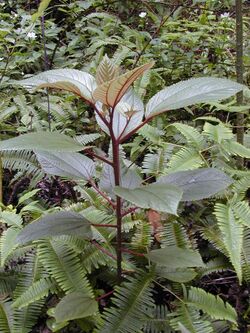Biology:Pipturus albidus
| Māmaki | |
|---|---|

| |
| Scientific classification Error creating thumbnail: Unable to save thumbnail to destination
| |
| Kingdom: | Plantae |
| Clade: | Tracheophytes |
| Clade: | Angiosperms |
| Clade: | Eudicots |
| Clade: | Rosids |
| Order: | Rosales |
| Family: | Urticaceae |
| Genus: | Pipturus |
| Species: | P. albidus
|
| Binomial name | |
| Pipturus albidus (Hook. & Arn.) A.Gray ex H.Mann
| |
Pipturus albidus, known as māmaki (sometimes waimea, for its resemblance to olomea[1]) in Hawaiian and known as Waimea pipturus in English,[2] is a species of flowering plant in the nettle family, Urticaceae, that is endemic to Hawaiʻi. It inhabits coastal mesic, mixed mesic, and wet forests at elevations of 60–1,830 m (200–6,000 ft). Māmaki is a small tree that reaches a height of 9 m (30 ft) and a trunk diameter of 0.3 m (0.98 ft).[3]
Uses
Medicinal
Native Hawaiians made a treatment for illnesses known as ʻea and pāʻaoʻao from the fruit.[4] They also combined fresh māmaki leaves with hot stones and spring water to produce herbal tea that was an effective treatment for general debility. Today, packages of dried māmaki leaves are commercially produced.[5]
Non-medicinal
The bast fibres were used by Native Hawaiians to make kapa (bark cloth) and kaula (rope).[4]
Ecology
P. albidus is the preferred host plant for the caterpillars of the Kamehameha butterfly (Vanessa tameamea).[3] Māmaki sometimes host the caterpillars of the green Hawaiian blue (Udara blackburni).[6]
References
- ↑ "Hawaiian-English Dictionary". University of Hawaii Press. 2003. http://wehewehe.olelo.hawaii.edu/cgi-bin/hdict?e=q-0hdict--00-0-0--010---4----den--0-000lpm--1haw-Zz-1---Zz-1-home-waimea--00031-0000escapewin-00&d=&l=en.
- ↑ "Pipturus albidus". Natural Resources Conservation Service PLANTS Database. USDA. https://plants.usda.gov/core/profile?symbol=PIAL2. Retrieved 6 October 2015.
- ↑ 3.0 3.1 Little Jr., Elbert L.; Roger G. Skolmen (1989). "Mamaki". Common Forest Trees of Hawaii (Native and Introduced). United States Forest Service. http://www.ctahr.hawaii.edu/forestry/trees/CommonTreesHI/CFT_Pipturus_albidus.pdf.
- ↑ 4.0 4.1 "mamaki, mamake, waimea (P. albidus on Kauai & P. ruber)". Hawaiian Ethnobotany Database. Bernice P. Bishop Museum. http://www2.bishopmuseum.org/ethnobotanydb/resultsdetailed.asp?search=mamaki.
- ↑ Krauss, Beatrice H.; Martha Noyes (2001). Plants in Hawaiian Medicine. Bess Press. pp. 85–88. ISBN 978-1-57306-128-5. https://books.google.com/books?id=Ku9pNKSsPTkC.
- ↑ Scott, James A. (1992). The Butterflies of North America: A Natural History and Field Guide. Stanford University Press. p. 399. ISBN 978-0-8047-2013-7. https://books.google.com/books?id=Oa5m8gZcGjMC.
External links
- "Pipturus albidus". Hawaiian Native Plant Propagation Database. University of Hawaiʻi at Mānoa. http://www2.hawaii.edu/~eherring/hawnprop/pip-albi.htm.
Wikidata ☰ Q16988147 entry
 |

